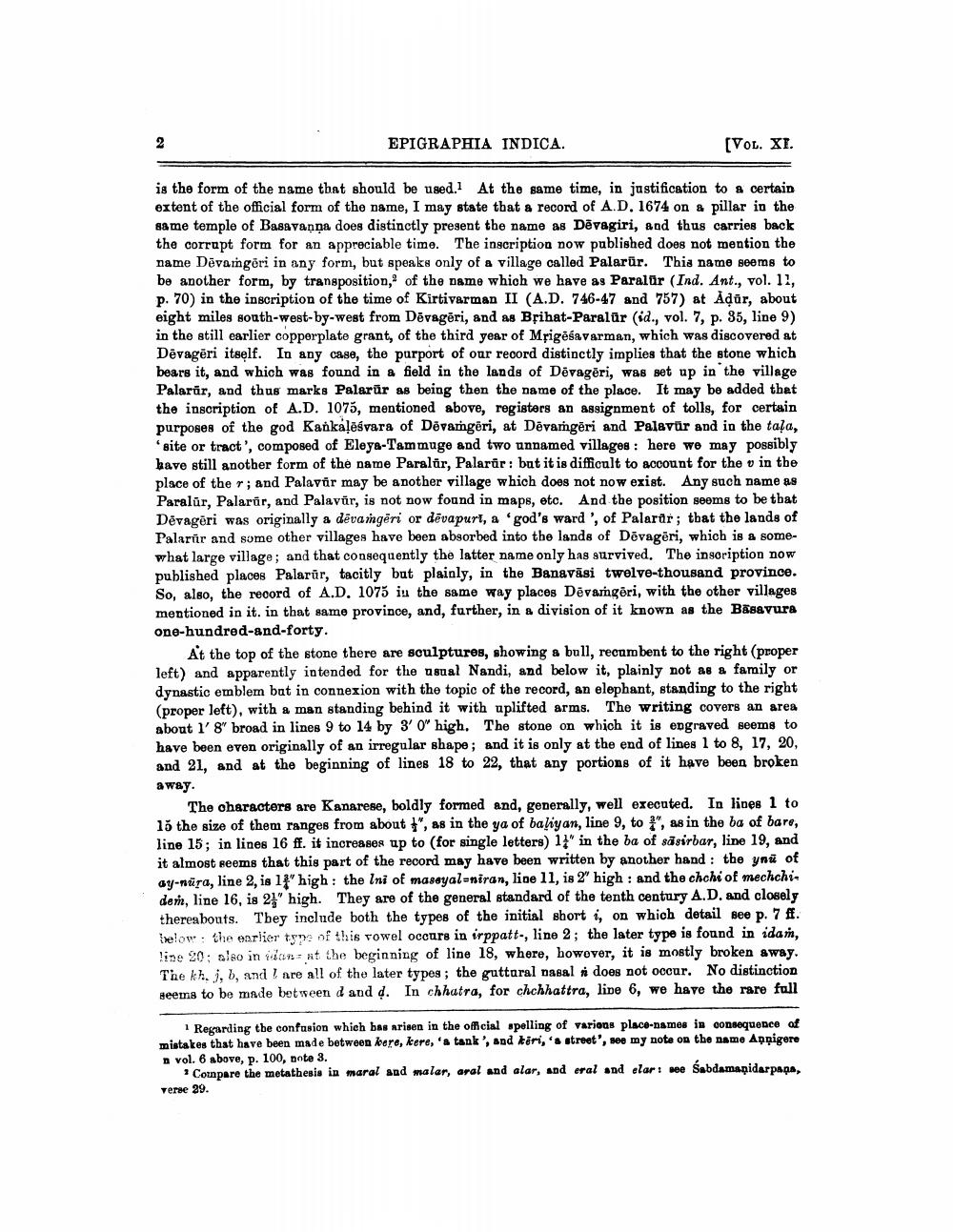________________
EPIGRAPHIA INDICA.
(VOL. XI.
is the form of the name that should be used. At the same time, in justification to a certain extent of the official form of the name, I may state that a record of A.D. 1674 on a pillar in the same temple of Basavanna does distinctly present the name as Dēvagiri, and thus carries back the corrupt form for an appreciable time. The inscription now published does not mention the name Dévangéri in any form, but speaks only of a village called Palarür. This name seems to be another form, by transposition of the name which we have as Paralür (Ind. Ant., vol. 11, p. 70) in the inscription of the time of Kirtivarman II (A.D. 746-47 and 757) at Aļür, about eight miles south-west-by-west from Dēvagēri, and as Bșihat-Paralūrid., vol. 7, p. 35, line 9) in the still earlier copperplate grant, of the third year of Mrigēśavarman, which was discovered at Dēvagēri itself. In any case, the purport of our record distinctly implies that the stone which bears it, and which was found in a field in the lands of Dēvagēri, was set up in the village Palarör, and thus marks Palarūr as being then the name of the place. It may be added that the inscription of A.D. 1075, mentioned above, registers an assignment of tolls, for certain purposes of the god Kankaļēśvara of Dēvamgēri, at Dēvamgēri and Palavür and in the tala,
site or tract', composed of Eleya-Tammuge and two unnamed villages : here we may possibly have still another form of the name Paralir, Palarar: but it is difficult to account for the v in the place of the r; and Palavür may be another village which does not now exist. Any such name as Paralur, Palarür, and Palavür, is not now found in maps, etc. And the position seems to be that Dévagöri was originally a dēvamgöri or dēvapurt, a 'god's ward', of Palarar; that the lands of Palarir and some other villages have been absorbed into the lands of Dēvagëri, which is a somewhat large village, and that consequently the latter name only has survived. The insoription now published places Palarūr, tacitly but plainly, in the Banavāsi twelve-thousand province. So, also, the record of A.D. 1075 iu the same way places Dēvamgēri, with the other villages mentioned in it. in that same province, and, further, in a division of it known as the Basavura one-hundred-and-forty.
At the top of the stone there are soulptures, showing a bull, recumbent to the right (proper left) and apparently intended for the usual Nandi, and below it, plainly not as a family or dynastic emblem bat in connexion with the topic of the record, an elephant, standing to the right (proper left), with a man standing behind it with uplifted arms. The writing covers an area about l' 8" broad in lines 9 to 14 by 3'0' high. The stone on which it is engraved seems to have been even originally of an irregular shape; and it is only at the end of lines 1 to 8, 17, 20, and 21, and at the beginning of lines 18 to 22, that any portions of it have been broken away.
The characters are Kanarese, boldly formed and, generally, well executed. In lines 1 to lõ the size of them ranges from about 1", as in the ya of bahiyan, line 9, to ", as in the ba of bare, line 15; in lines 16 ff. it increases up to (for single letters) 14" in the ba of såsirbar, line 19, and it almost seems that this part of the record may have been written by another hand : the ynü of ay-nura, line 2, is 14"high: the Ini of massyal-niran, line 11, is 2" high : and the chchi of mechchidem, line 16, is 21" high. They are of the general standard of the tenth century A.D. and closely thereabouts. They include both the types of the initial short i, on which detail see p. 7 ff. below the earlier tune of this vowel occurs in irppatt., line 2; the later type is found in idan, line 20: also in vianant the beginning of line 18, where, however, it is mostly broken away. The kh.), b, and I are all of the later types; the guttaral nasal does not occur. No distinction seems to be made between d and d. In chhatra, for chchhattra, line 6, we have the rare fall
Regarding the confusion which bas arisen in the official spelling of various place-names in consequence of mistakes that have been made between fore, kere, 'a tank', and tiri, '& street', see my note on the name Appigere n vol. 6 above, p. 100, note 3.
* Compare the metathesis in maral and malar, aral and alar, and eral and clar: see Sabdamanidarpana, verse 29.




